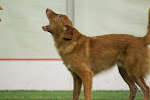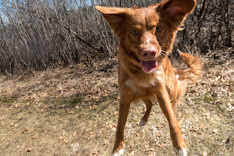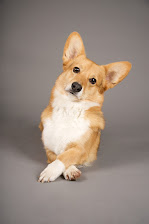Foundational Tricks!
Today's dog agility blog day is on backyard agility.
I live in a tiny duplex with an even tinier yard that is fenced to be even smaller due to the aggressive and always unleashed neighbor dog. The few agility equipment I own is stored away until I one day own that perfect big yard; flat and without trees of course. At least I live in Minnesota where for half of the year most everyone else is in the same position as me!
Backyard agility not so much. But there are things I consider crucial to our agility training that I can do inside. Tricks! Tricks are a great way to work on problem solving skills, body awareness, and to build a dog's strength and balance. I believe that a dog with a range of tricks has an easier time learning and performing in dog sports.
You don't have to be a great trainer to teach tricks and many don't even require the precision of a clicker. There are so many great tricks out there and lots of great trick tutorials out there; I can't wait to watch some of Silvia Trkman's DVDs on the subject :) I wasn't sure where to go with this topic until I started thinking that I know many people who get overwhelmed with it all and don't know where to start. They seem to get stuck with #1 having the time to do it and #2 not knowing what to train first.
Well the good news is that trick training doesn't take that much time. You don't need space and you don't need any extra equipment for most tricks other than a phone book or box. As I mentioned 2 weeks ago in my #1 advice for puppies, I train with my dog's meals whenever possible. This forces me to make time to train and it takes only 2-10 minutes per dog.
As for not knowing where to start, I've come up with a small list of what I consider the most important foundational tricks for agility. Meaning that once these tricks are mastered it should be easy to delve into others.
1. Front feet on a target. Wrap a phone book with duct tape so you start with a big flat surface. Lure or free shape, it doesn't matter how you start! But progress until the dog can offer to step on it from at least 5 feet. From here you can now dive into one of several other tricks such as:
- crossed paws
- drumming
- walking on your feet
- pivoting: highly recommended. I would have made it a foundational trick except that it can be more complicated to teach. Scratch that, it's my blog so this is now
1B. Pivoting. Teach the dog to move it's back feet around an object while the front feet stay on. SO important for hind end awareness and leads to super cool tricks such as:
- backward circles
- backwards weaving
- cool heelwork
2. Back feet on a target. Yes, this is just a 2o2o. But expand on it to obstacles other than the dogwalk such as a cooler, the couch, the wall! This trick allows you to build into adding height to the 2o2o for your handstand and hind leg lifts, or provides a great target for teaching backing up. Again, great hind end awareness!
- backing up (to the target)
- backing up stairs
- hand stands
- hind leg lifts
3. Beg. Balance and strength are worked on with this trick.
- squats (beg-up-beg transitions)
- penguin/ backwards penguin (moving in position!)
- hugging a toy
- beg-down-beg transitions
So there you go. 3.5 foundational tricks that are easy to do in a small space and guarantee fun.







awesome list - and i love the word foundational!!
I am having a terrible time getting Dexter to pivot his back end with his front end on an object. Any thoughts? He has trouble in general with doing anything where he isn't facing me.
I agree that trick training works best when I keep it simple and focus on some foundation behaviors. Right now, calm attention is what we need the most work with.
Mango Momma
Most people do start pivoting with the dog in front of them before they go to heel/side position, so not facing you shouldn't be a problem. Some people will free shape, but most people use pressure. Now since Dexter is a lab he's likely not very pressure sensitive, but he should still move his back end a tiny bit if you shuffle into his space. Just reward one step at a time, watching only his back legs. Once you have him pivoting around an object while you move around it, so he's staying in front position, you can progress to other variations. If you want to send me a video of where he's at now I can try and trouble shoot with you!